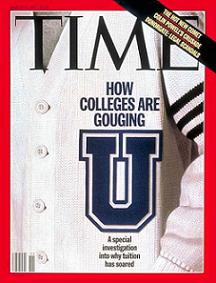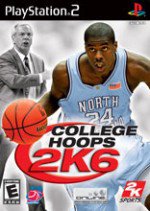 My thanks to Penn State/Dickinson Law School 2L Bobbi-Sue Doyle-Hazard and Attorney Chris Callanan for alerting me of the media coverage concerning an important federal antitrust lawsuit filed last Friday in the U.S. District Court for the Central District of California. The complaint was filed by several former Division I-A athletes who represent a class of thousands of former and current Division I-A men's football and basketball players. They seek to prohibit the NCAA from precluding member colleges from offering athletic scholarships up to the "full cost of attendance" (meaning all of the actual costs of attending college). Presently, scholarships may cover tuition, room, board and required books but not incidentals, such as phone bills, laundry, school supplies, and travel expenses. Particularly for players from lower-income families, "incidentals" can prove quite costly. In fact, according to the NCAA's own statistics, incidentals for basketball and football players average about $2,500 a year--for families hovering around the poverty line (which, for a family of four, is one that earns just under $19,000 a year), $2,500 obviously means a lot.
My thanks to Penn State/Dickinson Law School 2L Bobbi-Sue Doyle-Hazard and Attorney Chris Callanan for alerting me of the media coverage concerning an important federal antitrust lawsuit filed last Friday in the U.S. District Court for the Central District of California. The complaint was filed by several former Division I-A athletes who represent a class of thousands of former and current Division I-A men's football and basketball players. They seek to prohibit the NCAA from precluding member colleges from offering athletic scholarships up to the "full cost of attendance" (meaning all of the actual costs of attending college). Presently, scholarships may cover tuition, room, board and required books but not incidentals, such as phone bills, laundry, school supplies, and travel expenses. Particularly for players from lower-income families, "incidentals" can prove quite costly. In fact, according to the NCAA's own statistics, incidentals for basketball and football players average about $2,500 a year--for families hovering around the poverty line (which, for a family of four, is one that earns just under $19,000 a year), $2,500 obviously means a lot.
In terms of antitrust law, the complaint primarily concerns Section 1 of the Sherman Antitrust Act: the plaintiffs contend that these NCAA rules comprise an unlawful restraint of trade by denying men's basketball and football players of the billions of dollars in revenue they generate for the schools and conferences in which they play. The suit also alleges that this revenue should at least pay for the "full cost" of attending college. This argument follows the observation that Division I-A men's football and basketball seem to provide a economic windfall for just about everyone--the schools, conferences, coaches, sneaker companies, television networks, ad agencies, merchants, videogame companies--everyone, that is, except for the persons who actually generate the market interest: the basketball and football players. This is a topic, among others, that Joe Rosen and I address in our forthcoming essay in the Case Western Reserve Law Review.
Antitrust Act: the plaintiffs contend that these NCAA rules comprise an unlawful restraint of trade by denying men's basketball and football players of the billions of dollars in revenue they generate for the schools and conferences in which they play. The suit also alleges that this revenue should at least pay for the "full cost" of attending college. This argument follows the observation that Division I-A men's football and basketball seem to provide a economic windfall for just about everyone--the schools, conferences, coaches, sneaker companies, television networks, ad agencies, merchants, videogame companies--everyone, that is, except for the persons who actually generate the market interest: the basketball and football players. This is a topic, among others, that Joe Rosen and I address in our forthcoming essay in the Case Western Reserve Law Review.
How will this case resolve? I suspect we'll see a settlement, along with the NCAA assenting to cover more of the incidentals. The NCAA can't afford to lose this case: the lawsuit applies to 144 colleges, and if back compensation for "full cost" is imposed, around 20,000 affected athletes will receive an estimated $117 million in unreimbursed incidental expenses. Plus, NCAA President Myles Brand has previously enunciated a need to move closer to "full cost," so doing so now--even when threatened by litigation--would not likely appear contradictory.
For two excellent media accounts of this lawsuit, take a look at Mark Alesia's "Lawsuit: NCAA Should Pay 'Full Cost'" in the Indianapolis Star and Doug Lederman's "Court Challenge on Athletic Aid" in Inside Higher Ed. For more reaction from legal scholars, check out Hanno Kaiser at Antitrust Review and Josh Wright at Truth on the Market. And for analysis from a seasoned litigator, check out Tom Kirkendall's post on Houston's Clear Thinkers.
skip to main |
skip to sidebar
Blog Archive
-
▼
2006
(592)
-
▼
February
(39)
- Lack of AI? Culture Bias and U.S Olympic Basketball
- Why We Love Sports
- The Many Faces of Sports Law: Immigration
- NBA Age Limit and Questioning "Business Reasons"
- Brooklyn Law Review Article: It's Not About the Money
- Don't Tell Me The Results!
- Incidentals Matter: Antitrust Class Action Filed A...
- Engendering Change in the Olympics
- Mental Illness and Leadership Positions
- Stadium Security: Necessary or Invasive?
- Wouldn't You Have to Be Drunk to Wear This?
- Hold the Blood, Please: More Concerns for Food Sec...
- Jim O'Brien v. Ohio State University: Materiality,...
- Renegotiation of NFL Contracts: Comparing Chad Pen...
- David Stern on the Age Limit
- From the Land of Mike Dukakis to the Land of Trent...
- Michelle Kwan and the Risks of Marketing Olympians
- Jury Sides with Angels in Name-Change Dispute
- Hold the Spit, Please: Food and Beverage Security ...
- Kenyon Martin: Putting His Criminal Justice Degree...
- Defending the NBA Dress Code
- Low Fat Fiction
- NBA Dress Code Discussion Continues
- When Sports and Law Don't Mix -- Judge Apologizes ...
- Essay on Legality of NBA and NFL Age Limits in Cas...
- Not being Randy Livingston: The Jonathan Bender Story
- Thanks To Our Guests
- Tip of the E-Iceberg?
- Super Bowl Thoughts
- Super Bowl XL and Stadium Security
- Reciprocal Bootlegging???
- 113 Points
- Players Unions Need to Fix the Agent Business
- Teacher Violates First Amendment Rights of Young B...
- All Tyranny is Local
- Three Eyed Fish in the St. Louis Cardinals' Parkin...
- Patrick Dennehy's Old Coach Gets New Job
- SuperBowl Players Stuck Up in Michigan For $200K
- Duke Law School Symposium on Age Restrictions in P...
-
▼
February
(39)
Popular Posts
-
After a little over a week since 48 players exchanged numbers with their teams, and according to my research 13 players have signed if you i...
-
This is my opening post on my blog. This blog is going to be about the Media/ Sports/Music/Politicans. I hope ya'all find it interestin...
-
I am going ahead with the idea of facilitating barter exchanges between readers, chosing the old-school method in the interest of simplicit...
-
Male porn stars are famous for their above average endowments. Ron Jeremy is measured at 9.75 inches. Another famous porn star was John Holm...
-
I take what I call a journalistic interest in a variety of sports. If I didn't write, I wouldn't waste my time learning about them. ...
-
Paula Radcliffe is a distance runner who hails from Britain. She is the first woman to ever go below 2:20 for the marathon redefining what w...
-
Today's FT has a special report on Nigeria, and has a very interesting discussion of energy access : Despite average cash injections of...
-
Just wanted to thank everyone who has been apart, visited or entered our contests on this blog and help us get to 30,000. It's not quite...
Copyright © 2011 Sport News Update | Powered by Blogger
Design by Free WordPress Themes | Bloggerized by Lasantha - Premium Blogger Themes | Website Value Calculation Tool





0 comments:
Post a Comment